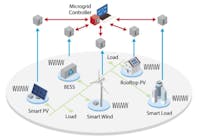Significant growth in widely distributed renewable energy generation has changed the nature of power transmission across the grid.
Instead of large centralized power stations transporting energy considerable distances to demand centers--and maintaining stable voltage and frequency as well as a balanced grid--lower power levels are more typically transmitted relatively short distances to local consumption and loads. For instance, commercial and domestic buildings are becoming part of the generation portfolio as they are used to support renewable energy systems like solar PV. The power they produce may be consumed on-site or delivered to neighboring buildings and users, but is far, far less likely to power an industrial installation hundreds of miles away.
This is the central characteristic of what is known as an autarkic or self-sufficient grid. Today, this concept is more widely known as the microgrid.
The Microgrid Challenge
Microgrids offer numerous benefits for both operators and consumers and are a rapidly growing phenomenon. In the New York borough of Brooklyn, for example, a microgrid project is using blockchain to enable peer-to-peer renewable energy trading. Microgrids also present opportunities to improve resiliency and can enable alternatives to traditional grid reinforcement.
However, generally more isolated from the wider grid and its stabilizing influence, microgrids are more acutely affected by the variability challenge too. Many smaller producers feeding their electricity into the local distribution grid can be problematic under certain operating situations. For instance, the direction of current flow in individual sections of the grid may be reversed at times or, when rates of distributed power feed-in are high, the existing transport capacity of the network may be insufficient. In addition, it is difficult to reconcile the weather-dependent and therefore fluctuating generation of renewable energies with the variable demands of consumers. This can lead to stability and reliability problems for microgrid networks--with overloading and breakdowns increasingly likely under these conditions.
In order to address these issues, a mechanism for network control is needed that can flexibly respond to high levels of fluctuating generation and ever-changing consumption internally, whilst maintaining reliable security of supply. One solution is to link microgrid networks with other local and regional networks in order to balance the changing consumption and production between microgrids when required. Here, the separate microgrid "cells" are effectively connected with a backup power supply, but to achieve this goal there is a need for active control.
The MVDC Approach
Medium Voltage Direct Current (MVDC) offers a solution to many of the microgrid and wider network stability and security challenges by delivering active control. Based on Siemens’ High Voltage Direct Current (HVDC) power transmission technology, like its high voltage cousin, MVDC also uses voltage-source converters (VSC) in a modular multilevel converter design (MMC).
In both HVDC and MVDC, two converter stations at either end of a DC electrical connection switch AC to DC and vice versa. HVDC not only offers long distance efficient energy transfer, it also effectively isolates frequency differences between grids. It is already an established technology having been successfully developed over a number of decades and Siemens has commissioned more than 50 HVDC systems worldwide to date. For example, this August Siemens and Mortenson completed the Bipole III HVDC converter stations in Canada. This 500 kV line will transmit 2000 MW of hydropower capacity from Manitoba Hydro’s northern generating stations near Hudson Bay almost 1,400 km across the challenging terrain and extreme conditions of the Province to near Winnipeg and the load centers in southern Manitoba and the United States.
Having developed the first MMC HVDC system in 2010, last October Siemens debuted its MVDC transmission technology for power ranges of around 30 to 150 MW. Significantly, MVDC also offers the ability to control, optimize, and regulate load flows in medium-voltage AC grids like those found in microgrid environments.
The use of insulated-gate bipolar transistors (IGBTs) means the commutation processes in the converters run independently of the network voltage and both converter stations can be also operated as static synchronous compensators (STATCOM) to provide precise quantities of lagging or leading voltage as a perfect sine wave. Able to shift active or provide reactive power within milliseconds, this enables control of both the voltage and frequency. These high-speed control and intervention capabilities ensure stability of the system, reducing network fault currents and malfunctions in the surrounding AC three-phase grid.
Furthermore, distances of up to 200 km or higher can be bridged with Siemens’ compact MVDC PLUS® technology at voltages of +/-20-50 kV, making the equipment suitable for connecting small communities in sparsely populated regions but also for connecting and stabilizing distribution grids, regardless of their voltage and frequency. By enabling regulated power exchange between microgrids as well as high voltage regional networks, MVDC builds stability and ensures security of supply for microgrids - even in the event of extreme fluctuations in energy supply and demand.
MVDC Benefits
Although based on well-established technologies and principals, MVDC is relatively new. Nonetheless, the potential advantages of its use are increasingly being recognized. For instance, as early as 2015 in a study commissioned by Scottish Enterprise and distribution company SP Energy Networks, TNEI Services identified potential opportunities for MVDC over the coming decade and more.
In particular, the analysis identified MVDC as a solution to a variety of challenges associated with integrating renewable generation into the electricity network, in particular, offshore renewables, and network reinforcement. As part of the TNEI analysis an offshore wind case study demonstrated that direct MVDC connections would be cost-effective if the cost of electricity from offshore wind were to fall to around STG£100-120/MWh (US$130-156/MWh) – it is perhaps worth noting that the latest European offshore wind projects are expected to produce power priced at around half of that threshold.
Existing AC systems must operate at high voltages for efficient energy transmission over long distances and typically require reactive power compensation too. Indeed, when using AC the transmission line losses effectively rule out medium voltage solutions.
Nonetheless, an onshore distribution network case study from TNEI further showed that an MVDC link can be an efficient way to reinforce a network. For example, over the asset’s lifetime the reduction in transmission losses proves to be a significant benefit of the MVDC link, when compared to conventional
reinforcement. The TNEI study concludes that MVDC could provide a more cost-effective option than the “business as usual” technology.
Another benefit of the MVDC approach is the compact size. With lower voltages in play, distances between conductors and potential earths can be far shorter, allowing for smaller transmission towers and more compact converter stations. Under these circumstances existing cables and overhead lines may be used to increase power capacity without the investment associated with stepping up the voltage.
Furthermore, lower voltage MV components are naturally cheaper than HV components due to their less demanding electrical insulation properties, for example, and there are more suppliers in the market providing these components. Thus the components within MVDC systems are more likely to be standard modules and can be smaller whilst retaining the desired reliability and performance characteristics.
In addition, HVDC developments tend to be tailored, with controls and systems precisely designed for specific applications. MVDC has been developed as a product solution, with Siemens offering the system in three power transfer capacities of roughly 50, 100, and 150 mW. This standardized approach significantly reduces the cost of additional engineering for individual applications and also reduces the lead time for project development.
Building a Market for MVDC
With its medium voltage DC approach, Siemens has an efficient and cost-effective solution to increase microgrid stability and reliability, as well as supporting regional power transmission networks.
Key applications for MVDC PLUS® include linking islands with a mainland grid to avoid expensive maintenance and the high cost of backup power generation, for example using diesel generators. It is also ideal for connecting communities in sparsely populated regions and providing greater independence from the high voltage grid where current connections are limited or do not exist. MVDC also supports the connection and stabilization of weak distribution networks, regardless of their voltage and frequency, by enabling the regulated exchange of power between regional electricity grids.
In microgrid and other applications, to these benefits are also added the active control element for optimal operation and stability of the grid, as well as the advantages of decoupling voltage, frequency and “grid quality” between microgrids and the regional electricity network.
With renewables growth and other trends like electric vehicles expected to increase demand for control, flexibility and resiliency, for a host of reasons microgrids are anticipated to become an attractive approach for multiple sectors and applications. MVDC delivers the key elements of stability and security with the essential cost advantages that make it a prime solution to the microgrid challenge.


